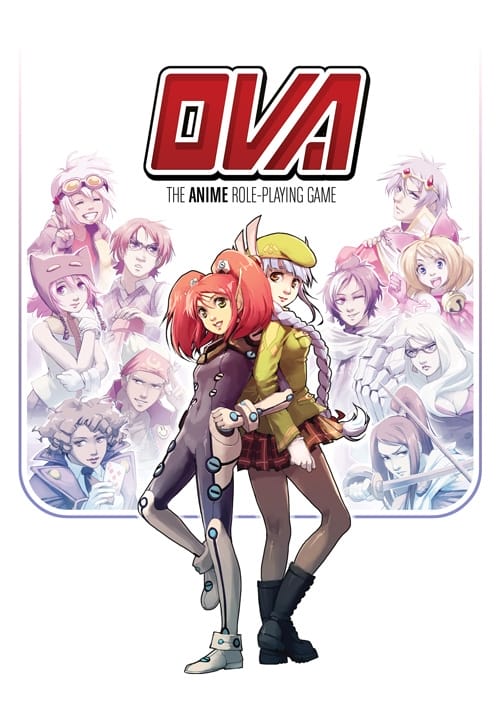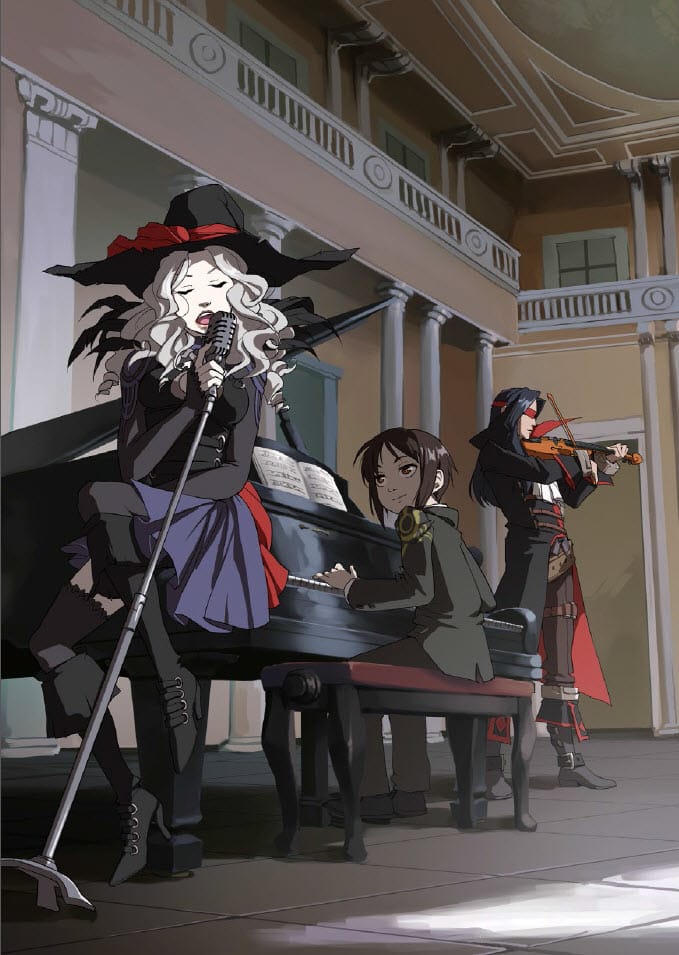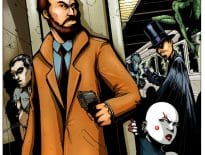OVA stands for “Open Versatile Anime”. The OVA RPG is an old one; even DriveThru RPG records the original first being uploaded to their catalogue back in 2012. The physical book has been out of print for ages.
Times are changing. Anime is far more popular now. That’s partly thanks to the rise of cosplay and conventions but also the internet making it easier for fans outside of Japan to access shows. Last year OVA wisely popped up at Kickstarter and raised over $110,000 in funds. I went big in by backing; grabbing a large hardback rulebook. Okay. I suck at filling in Kickstarter prompts so I’m not sure where that book is (late, perhaps, mislaid, perhaps) but at the start of this month I got prompts to download the PDF copy of the new game. I now have a copy of OVA: The Anime Role-Playing Game Revised Edition.
There are three key takeaways;
- This is a gorgeous RPG. Niko Geyer’s anime illustrations are wonderful.
- OVA successfully captures the feeling of anime.
- This is an updated “second generation” RPG.
Okay, so what’s a “second generation” RPG? Some folk might say “OSR” but I hate how badly defined that term is; meaning different things to different people. Second generation means a clever and slick use of stats for action orientated game mechanics. “Storytelling” games are the third generation.
OVA’s dice system is actually rather nice. If you’ve a +1 in an ability then you’re better than average. To see if you’re successful you two 2d6, take the best and see if you beat the target number. If you’ve a +1 in a relevant ability then you roll an extra dice; 3d6.
The catch – and this feels appropriate for the levels of success and failure we see in anime – doubles add together. So if you roll 3d6 and roll 3, 3 and 5 then the two 3s add together for 6. That means you’ve rolled 6. If you roll 4d6 and get 3, 3, 3 and 5 then the three 3s add together for 9.
As a result the extra dice are pretty hefty wildcards. With a mere +1 your top success goes from 6 to 12 but you’ve an equal chance of your bonus being 2 (two 1s) as it is of being 12 (two 6s).
Already in the system we can see how OVA makes sure it pays attention to the sort of action styles commonly found in anime. There are other examples. In the experience point system the rate of advance depends on the type of game you’re playing. If you’re playing a heroic level game (imagine Naruto discovering new powers in almost every episode) then you boost your abilities at the rate of 1 xp per level. In a standard game the exchange rate is 2 xp per level. Lastly, if you’re playing a limited game – imagine veteran cops in a noir setting when most characters are unlikely to develop new abilities – then the cost per level increases to 3 xp per level.
As tends to be characteristic of “second generation” RPGs OVA begins with details on how to create characters and it is a straight forward. The range of abilities available to characters are then augmented by advantages and disadvantages. Here you try and build a character that feels right while balancing the points you have to spend.
OVA has a rather handy rule of thumb for GMs trying to balance difficulties and encounters with PCs. As the ability pool isn’t too huge you can do some maths to compare “threat values”. Here’s OVA’s own text;
Every character in OVA has a Threat Value. This number can give you a better handle on how to balance conflicts in the game.
Simply add the following without taking into account any Perks or Flaws: The character’s Attack Roll, Defense Roll, Damage Multiplier, Level in Armored, and the Levels of any Abilities or Weaknesses that modify Health and Endurance.
For example, Attack, Strong, and Weak should be included, but not modifiers from the Ability Perk Effective or the Flaw Ineffective. Quick but not Defensive, and so on. If a character has multiple options for a given item, use the best one.If a character has an Ability that does not affect any of the above, yet could prove particularly useful to an encounter, include it in the Threat Value but halve its Level, rounded up. Abilities like Heal and Magic are good candidates. Companion and Min-ions are not. Calculate their TVs separately.
Finally, take NPC type into account. Subtract 4 from Secondary NPCs’ TV. For Extras, 8. Add 5 for each Boss Ability used.
To create a balanced encounter, com¬bine the TVs of all PCs, choose a difficulty below, and use the multiplier to generate a rough estimate of your oppositions’ TV.
Once you have the Threat Value of the NPC you can gauge the difficulty estimate. If the enemy TV is a ¼ of the PCs then it’ll be an Easy encounter, ½ is a Moderate encounter, ¾ is challenging, a ratio of 1:1 is dead even but if we go up to 1 ½ then it’s an unlikely victory and a ratio of 2 means victory is “nigh impossible” for the PCs.
I think the Game Master’s Section in OVA is punchy. It’s not huge but it’s very effective. I’ll run through the section headings within it as they sound like a clever guide to running a great game.
Getting Players to Care
- Set the Scene
- Make NPCs that Matter
- Remember Who the Heroes Are
- Give Everyone Their Time to Shine
- Reward Players for Playing
Pacing and Direction
- A beginning, a Middle, and an End
- Keep the Gaming Going
- … But Avoid Railroading
The game’s author, Clay Gardner, has thankfully included a decent section on Japan and Japanese/anime storytelling traditions in particular. Know when to use –chan or –kun as honorifics? This is the section that tells you.
It’s hard to imagine that anime fans won’t know about the tendency to name your attacks, have rivals turn into allies or be confused by the magical girl genre and it is equally hard to imagine non-anime fans reading OVA. You might then wonder whether it was worth including summaries for this sort of thing in the RPG? Surprisingly it works. Perhaps these little paragraphs work because they’re too the point reminders rather than a 101 essay. I enjoyed reading through each.
I only have a few grumbles with OVA. Mainly I wish it would have swapped the character building section with the telling anime stories section. You need to know what sort of character to create after all – but thankfully the game makes the point of encouraging players to work together and with the GM for chargen.
My biggest problem with the PDF was reading it on my Nexus 7. This 165-page full colour PDF kept on crashing my Kindle app. It must be too large or awkward. I had to resort to reading it on my desktop. I think if I was to try and play the game I’d have to dust off my Kindle Fire HD and see whether the dedicated device could cope… or I’d have to wait and see whether my expensive physical book manifests.
In conclusion – this seems straight forward to me. Are you a roleplayer and an anime fan? Yes? Grab the revised edition of OVA: The Anime Role-Playing Game (due out 31st August). Did you answer “maybe” to either half of that question? Then maybe consider OVA. Know full well that you dislike anime? I doubt OVA will be in your game consideration list.
I’m glad I backed this at Kickstarter.
When the game becomes available you should find it here at DriveThru RPG.




